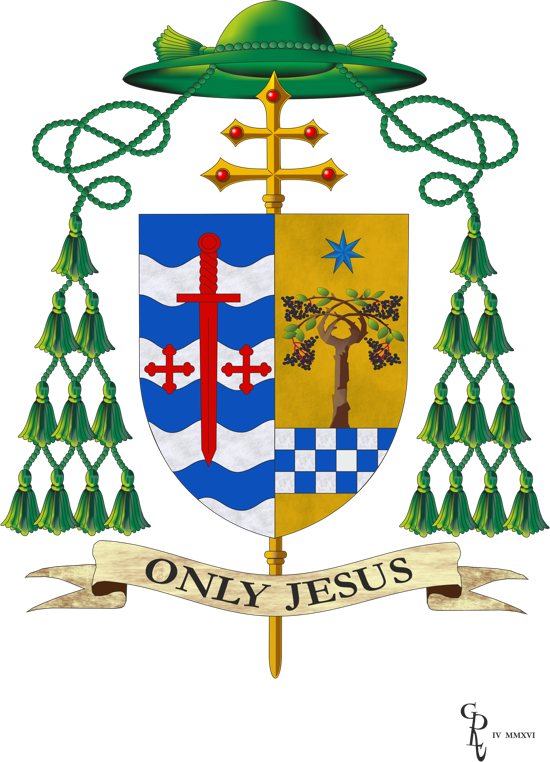
A bishop’s coat of arms traditionally has four parts: a shield with “charges,” or symbols, signifying his family, home or religious devotions; a processional cross representing his rank as bishop; a green pilgrim’s hat; and a scroll with his motto. The following is a basic explanation of Archbishop Bernard Hebda’s coat of arms, which, upon his installation as archbishop of St. Paul and Minneapolis, is merged with the archdiocesan crest, which was established in 1920 under Archbishop Austin Dowling. The archdiocesan crest is represented on the shield to the viewer’s left, and Archbishop Hebda’s personal crest is represented on the right.
Wide-brimmed hat
The green, wide-brimmed pilgrim’s hat is part of traditional heraldry, or the design of a coat of arms. Also known as a “galero,” the hat was once commonly worn by Church prelates. The symbol includes chords and “fiocchi,” or tassels. An archbishop’s coat of arms includes 10 tassels on each side of the shield.
Processional cross
Like the hat, the processional cross is also a traditional heraldic symbol. The double-armed processional cross, or metropolitan cross, signifies an archbishop. The cross in Archbishop Hebda’s coat of arms has five red stones to represent the five wounds of Christ.
Azure star
The blue, seven-pointed star at the top right of the shield signifies Mary and Archbishop Hebda’s placement of his pastoral ministry under her protection.
Elderberry tree
The elderberry tree symbolizes Archbishop Hebda’s Polish ancestry. The tree is widely found in southeastern Poland, from where Archbishop Hebda’s paternal grandparents emigrated. The tree’s Polish name, “bez heb,” also serves as a visual pun of “Hebda.”
The tree also has a theological meaning; as one of the first plants to show signs of life after winter, it is also used to symbolize hope for a season of fertility and graces. According to an official document explaining the blazonry of Archbishop Hebda’s coat of arms, “Being strong and fruitful, the elderberry has also been identified with constancy and pastoral zeal, fundamental traits expected of any bishop.”
Berries
The seven green berries — reminiscent of rosary beads — at the top of the tree are a sign that he was named a bishop on Oct. 7, the feast of Our Lady of the Rosary. With the additional eight berries at the bottom of the tree, the total 15 berries symbolize Mary’s assumption, celebrated Aug. 15. The Norbertine monastery in Hebdów, Poland, was dedicated to the Assumption in the 12th century, and “Hebda” was a common name among those who lived and worked on the monastery’s lands.
Fruit
The four clusters of fruit on the elderberry tree are a sign of the cardinal virtues — prudence, justice, fortitude and temperance — which “sustain the pastoral activity of the bishop.”
Chequy fess
The checked pattern is adopted from the coat of arms of the Diocese of Pittsburgh, where Archbishop Hebda grew up and was ordained a priest July 1, 1989. According to the blazonry explanation, the placement of the tree on the chequy fess “recalls that Bishop Hebda has roots in the Diocese of Pittsburgh and has drawn his strength from that local Church.”
Gold background
As the noblest of metals, gold symbolizes faith, which provides the strength to support Archbishop Hebda’s pastoral ministry.
Waves
The white and blue waves represent the waters of the Mississippi River.
Sword
The red sword represents the archdiocese’s namesake, the apostle St. Paul.
Crosses
The two red crosses represent the Twin Cities of St. Paul and Minneapolis.
Motto
Archbishop Hebda’s motto is “Only Jesus.” It’s taken from Mark 9:8, which is part of an account of the Transfiguration: “Suddenly, looking around, they no longer saw anyone but Jesus alone with them.”
The words are also the ending of a prayer written by Blessed John Henry Newman, whom Archbishop Hebda admires. Part of the prayer is printed on cards the archbishop had designed for his installation as archbishop of St. Paul and Minneapolis:
“Dear Jesus, help me to spread thy fragrance everywhere I go. Flood my soul with thy spirit and love. Penetrate and possess my whole being so utterly that all my life may only be a radiance of thine. Shine through me and be so in me that every soul I come in contact with may feel thy presence in my soul. Let them look up and see no longer me but only Jesus.”
The Missionaries of Charity, for whom Archbishop Hebda served as a confessor while living in Rome, pray the prayer each morning, according to the practice of the order’s founder, Blessed Teresa of Kolkata. The motto reminds the archbishop of the sisters’ exemplary humility, obedience and fidelity, and that his ministry is to lead the faithful to Christ.



